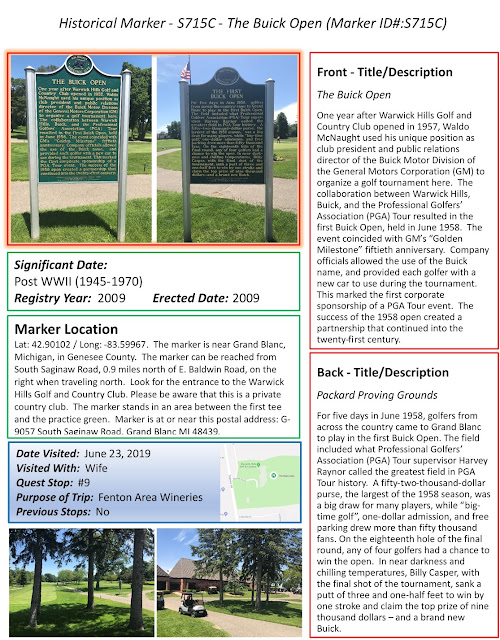Western Knitting
Mills
Date Visited: July 19, 2019
Stop: #20
For the second time in a row
(albeit, 16 days apart), Kathy and I went on a quest that involved:
- One historical marker that we had passed or visited hundreds of times before,
- Did not involve a visit to a Michigan winery,
- Included a special guest.
We had not visited an
historical marker since July 3 when we visited a marker in Caseville with our
son, David, in tow. This time around,
our target happened to be a restaurant in downtown Rochester that is a favorite
of ours, and instead of our son joining us, we had our daughter, Sarah, tagging
along. Sarah has been one of our biggest
“fans” and would probably be joining us on many of our quests if not for the
fact that she lives in Germany. So, we
were blessed to have her home for a few weeks this summer and she was excited
to join us on any quest, no matter how short it may be. She had been home for only a couple of days
when we had an opportunity to introduce her to our quest.
It was a Friday night and
neither Kathy nor I felt like cooking.
We started a diet back in March and really had not gone out to eat much
since then, so eating out was a big treat.
However, it was also a challenge since we had to go to a restaurant that
could provide food options that fit into our very restrictive diet. Rochester Mills Beer Company, which is a very
popular restaurant in downtown Rochester, was our pick. They have great seafood options as well as
many salad choices that fit our diet, but also serve steaks, chicken dishes, a
wide assortment of pub sandwiches, brick oven pizzas, pasta dishes, jambalaya,
and a buffalo chicken mac & cheese dish to die for (which, unfortunately,
does NOT fit into my diet). The
restaurant is also known for the many different craft beers that it brews
onsite.
Rochester Mills Beer Company happens
to be located in the building that used to be the Western Knitting Mills, an
historical building that was granted a Michigan Historical Marker in 2003 and is
also listed on the National Register of Historic Places (in 2000). Since we had visited this restaurant many
times in the past, this marker was very familiar to us, but just like the sign
in Caseville, this was the first time we had visited it on our Michigan Wines
and Signs quest.
The marker is located at 400
Water Street outside the entrance to Rochester Mills. The building is easy to identify – a massive
brick building with two stories of beautiful arched windows and a three- story
tower on its northwest corner. The sign
marks the site of the first woolen mill built by Hosea Richardson in 1844 on
the banks of the Paint Creek. The
original building was destroyed by fire in 1867 and a new building was constructed
soon after and purchased by Hosea’s son, Samuel. The new building was home to the Rochester
Woolen Mill. This building also fell
victim to a fire in 1882 and was completely destroyed. In 1896, the Western Knitting Mills was
constructed on this site (after buying our Samuel’s interest in the company). The building supported a yarn mill,
dormitories, and two warehouses. It also
had its own hydro generating station and a railroad spur directly onto its
property. The marker states that the
mill was the largest employer in the area in its day, and produced wool socks,
gloves, and mittens until 1916, then made wool cloth, and khaki gloves for our
soldiers during World War I. After the
war, business declined and the mill closed in 1927. It reopened again in 1929 after it was
purchased by the Bradley Knitting Company of Wisconsin and produced yarn and
knitted cloth. With the onset of the
Great Depression, business declined yet again and the mill closed for a second
time in 1931. The mill opened again in
1933 but ceased operations permanently in 1939.
The building then became home to many companies beginning in the 1940’s
but finally closed in 1993 and sold to private owners in 1997. The building was renovated for commercial use
and reopened with several new businesses residing there, including the
Rochester Mills Beer Company.
We had a wonderful dinner and
Sarah enjoyed being a part of the quest.
The food at Rochester Mills is fantastic, and the beer is pretty good
too. I know, this isn’t a blog about
beer, but it is worth checking out if you happen to be a beer lover. They do happen to have a very extensive wine
list, but there are very few Michigan wine selections. It would be great if someday they could
feature more Michigan wines – it seems like a natural fit since they are a
restaurant featuring Michigan brewed beer!!!
#michiganwinesandsigns #michigan #history #michiganhistory #wine #michiganwine #winetasting #historyisbetterwithwine













